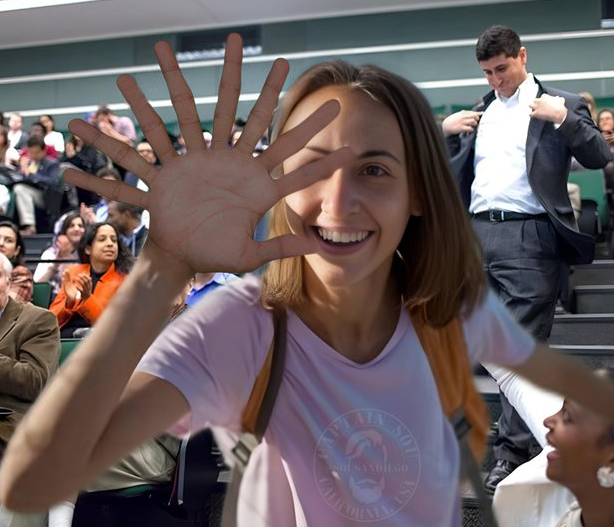Written by Samuel Johnson.
In a shocking twist of events that had political pundits and meme enthusiasts alike rubbing their eyes in disbelief, Vice President Kamala Harris has firmly denied accusations that her most recent rally was populated by AI-generated spectators. That’s right, folks. The woman who has occasionally been known for speaking in word salads now finds herself defending the very existence of her audience.
The accusations started flying after images of Harris’s rally began circulating online, showing a crowd that some claimed appeared “too perfect.” You know, the kind of perfection that only a Silicon Valley coder with too much time on their hands could create. Rows of neatly aligned people, all with identical smiles, clapping in eerie unison—either Harris is a magician, or someone hit ‘Ctrl+C, Ctrl+V’ a few too many times.
Harris, with her usual blend of charisma and condescension, was quick to shut down these claims. “These allegations are baseless and ridiculous,” she said, with the kind of conviction usually reserved for declaring one’s favorite ice cream flavor. But let’s be honest, in an era where deepfakes and AI are part of the daily lexicon, can we really trust what we see anymore? Or, in this case, can we trust that anyone actually sees Kamala Harris?
The Crowd That Almost Wasn’t
To the delight of tech enthusiasts and the dismay of, well, pretty much everyone else, the controversy didn’t end there. As if the internet needed another reason to question reality, some eagle-eyed viewers began analyzing the footage, pointing out anomalies that would make even a seasoned CGI artist blush. From the occasional glitchy handwave to the oddly synchronized head nods, it seemed the only thing missing was a “Loading…” icon hovering above the crowd.
Of course, Harris’s team fired back, labeling the accusations as nothing more than conspiracy theories cooked up by “anti-democratic forces.” But the more they tried to deny, the more the public became convinced that something was up. After all, who among us hasn’t been to a poorly attended rally and thought, “Gee, if only I had an army of digital clones to fill the seats”?
And let’s not forget the implications here. If political rallies are now being staged with digital audiences, what’s next? Virtual applause for every awkward pause? A holographic protester to boo at all the right moments? The possibilities are endless—and terrifying.
When Reality Becomes Optional
The Harris rally debacle has opened up a Pandora’s box of questions about the future of politics, media, and our increasingly fragile grip on reality. If you can create a crowd out of thin air—or in this case, thin code—what does that say about the authenticity of political discourse? Are we now living in a world where political engagement can be faked as easily as a social media post?
The most ironic twist? The possibility that the very people who accused Harris of using AI to boost her crowd numbers might themselves be bots. Yes, the internet is that meta. Imagine it: a battleground of artificial intelligence, where deepfake rallies are attended by deepfake citizens, all arguing over what’s real in a world that’s anything but.
It’s enough to make anyone question whether they should trust their own two eyes—or the countless pixels that make up the images on their screens. Because in this brave new world, the line between reality and fiction isn’t just blurred; it’s been pixelated, compressed, and rendered unrecognizable.
Our Take
The notion that Kamala Harris—or any politician—might resort to populating their rallies with AI-generated crowds is both hilarious and horrifying. On one hand, it’s a comical commentary on the state of modern politics, where image is everything and reality is negotiable. On the other hand, it’s a chilling glimpse into a future where truth becomes entirely subjective, manipulated at the whim of whoever controls the algorithms.
This isn’t just bad for public discourse; it’s downright dystopian. If we can’t trust that the people in the crowd are real, how can we trust that the messages being delivered are genuine? The erosion of authenticity in political rallies could lead to an erosion of trust in our entire democratic process. After all, if politicians can fake a crowd, what else can they fake? The line between reality and simulation is growing thinner by the day, and we should all be concerned about what that means for our society.
So, is Kamala Harris’s crowd real or just another digital mirage? In a world where technology can bend reality to its will, perhaps the better question is: does it even matter?

